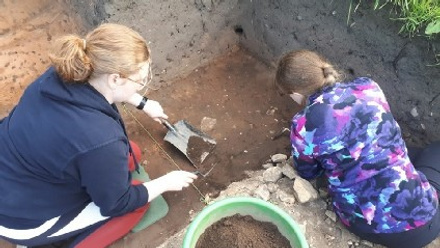This training school is designed to provide training and experience in various aspects of the post excavation process. All tuition and training will be carried out under the supervision of experienced tutors, with finds training lead by Mercian's ceramic specialist David Budge.
The course is designed to give delegates an understanding of what is involved in the post excavation process for finds, ranging from initial cleaning and processing of the finds as they come out of the ground, through to some of the specialist analysis that finds are subject to, through to illustration and preparation of the finds for publication.
The course is designed to allow delegates to gain experience of handling finds and to develop the ability to look at artefacts critically with a view to recognizing the clues that give evidence of what they were used for and that can help to identify them.
The course also provides training in archaeological drawing techniques including preparing plans and /or sections for publication, and training in working with site archives to create site matrices.
Delegates will also learn basic archaeological GIS (Geographic Information Systems) including working with survey data, preparing maps, working with historic mapping, creating layouts and exporting data.
Your Training Includes;
Finds processing;
- The course will allow delegates to become familiar with a range of artefacts of different materials and types.
The training on finds processing will involve you:
- Carrying out initial processing of finds as they come from site (including correct handling procedure, what can be cleaned and what cannot, how to clean the things that can be cleaned, how to recognise when to call in specialist conservators)
- Carrying out marking of finds, knowing what details to mark and the best place to mark
- Carrying out an initial sorting of the cleaned finds, learning to recognise artefacts of different types made from different materials and how to package them for storage, conservation, or to be sent off for specialist analysis.
There will also be an opportunity to participate in some of the more specialist aspects of post excavation finds work, primarily focused on pottery.
There will be opportunities to:
- Learn some basic rules that can help delegates to undertake basic dating of pottery from the region through taught sessions and hands on artefact handling.
- Learn about some of the standards and guidance used by ceramic specialists and the different stages of analysis that may be undertaken by specialists in the post excavation process, from initial scanning and spot dating, to assessment, through to analysis and quantification.
Under supervision delegates will:
- undertake the scanning of contexts for spot dating purposes.
Delegates will also:
- undertake supervised quantification of artefacts excavated from King John’s Palace.
Delegates will also be taught finds illustration, focusing on ceramics, learning how to produce publication-ready archaeological illustrations.
Delegates will experience the whole process of producing archaeological illustrations of pottery from initial pencil drawing to inking and then scanning and processing the illustrations ready for publication.
Archaeological post-excavation training
The course also provides training in archaeological drawing techniques including preparing plans and /or sections for publication, and training in working with site archives to create site matrices.
Delegates will also work with context sheets, and create site matrices from a site archive, and drawings.
Archaeological GIS
Delegates will work with survey data and learn how to create maps, vector layers and geo-
A Geographic Information System (GIS) is a system designed to capture, store, manipulate, analyse, manage, and present spatial or geographic data.
Archaeologists use GIS for many things including creating maps, analysing landscapes, understanding archaeological sites, creating 3D models, viewshed analysis, presenting survey data and more.
GIS is a great way to integrate data from projects and can be used to analyse that data as well as present it in the form of maps for publication.
The images to the left include GIS being used in building analysis, surveying, map work, and the displaying of geophysical survey data.
Delegates are required to bring a laptop to the course in order to undertake these elements of the course.
*Please note that while aspects of this course will be in-
This course is suitable for all levels from beginner to experienced archaeologist .
For those wishing to develop their skills, for students and post-

